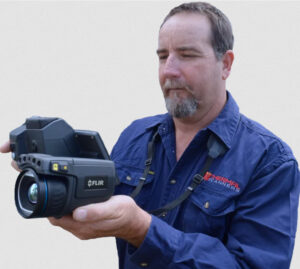
Thermal imaging refers to the method to use thermal energy and infrared radiation to gather information regarding objects. The aim is to create images even in environments with low visibility. Through the years the technology has developed a range of applications especially as night-vision technology. This can work effectively even in the dark, haze, smoke, smog, or fog. It works on the basis of heat or infrared energy emitted from various objects. This is the heat signature with radiation quantity emitted is proportional to heat content of the object. Both thermal imagers and cameras are sophisticated and contain heat sensors.
The highly sensitive equipment can identify even the minutest temperature differences. This gather radiations in particular environment from different objects mapping out images through temperature measurement inflections and differences. The grayscale thermal images contain black showing colder regions, white areas representing heat, and gray shades for temperature gradient between the other two. The new camera models add image colors so that the users can identify the distinct objects better and more clearly. The colors used include purple, orange, red, yellow, and blue. Some major applications of thermal imaging are the following.
Electrical maintenance
This field has extensive application of thermal imaging. The power line experts use imaging for pinpointing and locating parts and joints at overheating risk. These emit more heat already than the stronger sections. The imaging method spots any failing devices or loose connections.
Building and mechanical construction
Technicians use the imaging technique when handling thermal insulation to identify leaks quickly and this helps to maintain an efficient building temperature through thermal patterns. This imaging analyses the spot faults and structure of the building along with walls losing heat. They examine the thermal performance of windows, doors, and HVAC equipment. The thermal imaging camera picks up such information easily.
Plumbing
This is for inspection of possible leakage spots through pipes and walls. You can use the devices from a distance so they are ideal to find equipment problems. Drone thermal inspections are especially useful for hard to reach areas that may pose safety hazard to the workers.
Pest and animal management
This field offers plenty of opportunities to use thermal imaging techniques as this sports the animals or pests in areas of the roof that are not visible clearly or the dark corners. There is no need to climb on the dangerous roof to detect termite activities for example. This is a good way to do wildlife surveys in a non-intrusive and non-invasive manner.
Medicine and healthcare
This is another practical application of the technology to spot temperature anomalies and fevers. It is used popularly in the airports to scan the passengers accurately and quickly for high temperature. This is an effective method to screen the traveler for Ebola, SARS, and more recently Coronavirus. Imaging can detect various disorders of the limbs, back, neck, and circulatory issues through thermal patterns.
Transport navigation
Travel during night especially the field of maritime navigation benefits immensely from the thermal imaging technique. Experts use this technology to view other vessels clearly along with obstructions and people.

